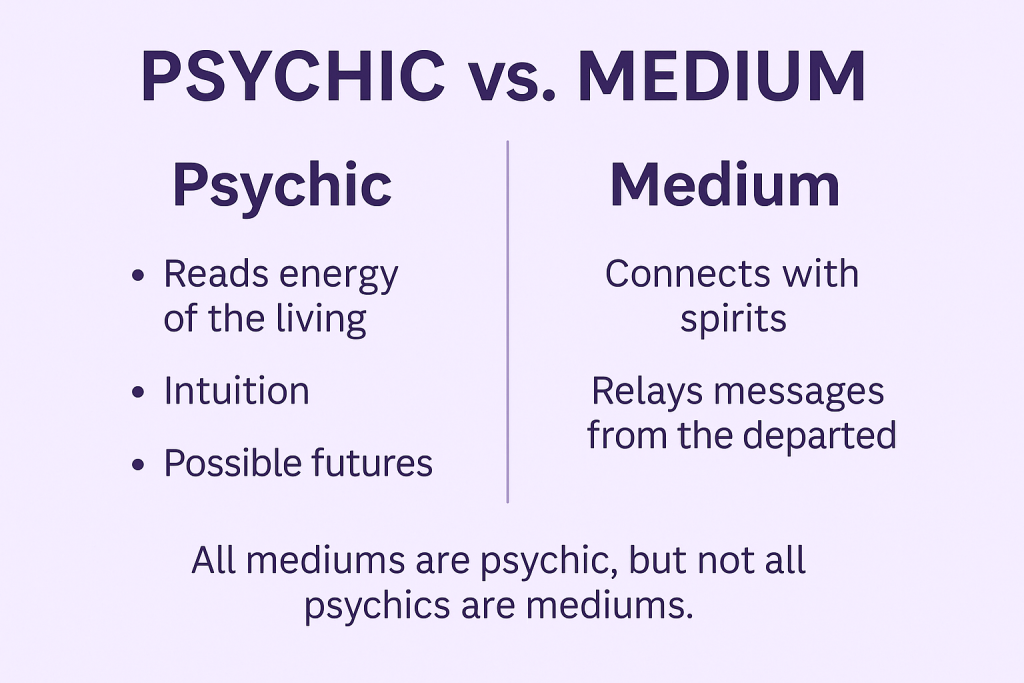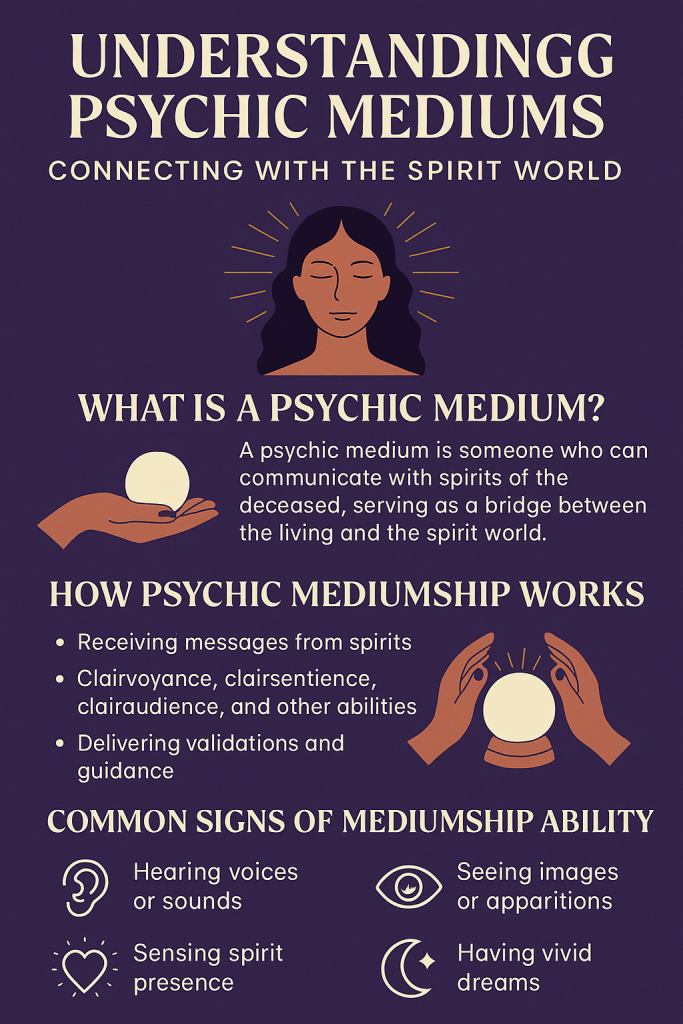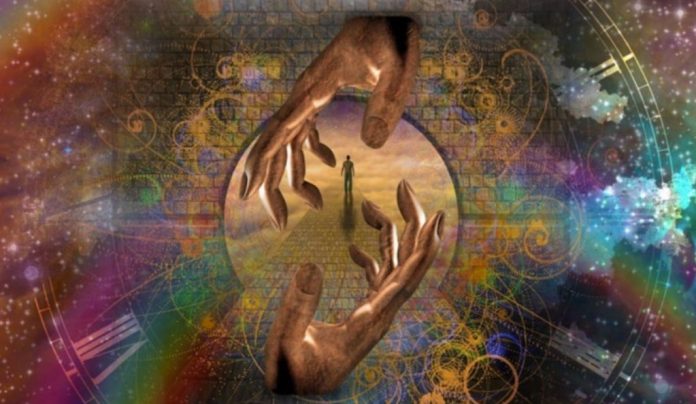Imagine walking into a room and instantly feeling a presence, even though no one else is there. Some people brush it off as imagination, while others recognize it as a brush with the unseen. For centuries, human beings have turned to those who claim the ability to translate these invisible experiences—the psychic mediums. They are often misunderstood, painted in pop culture as fortune tellers with crystal balls or spooky séance hosts. But the reality is much more layered, compassionate, and surprisingly relevant to modern life.
Psychic mediums see themselves not as performers but as bridges. Their work is about translating energy from those who have passed into messages for the living. It’s a practice as old as humanity itself. Across cultures, we find shamans, oracles, and spiritualists filling this role: connecting the earthly with the otherworldly, and giving voice to what cannot be seen.
What sets mediums apart from other psychics is their specific focus. While psychics can tune into the energy of living people and possible futures, mediums claim to sense and communicate with spirits—most often deceased loved ones. They may describe themselves as clairvoyant (seeing images), clairaudient (hearing voices or sounds), or clairsentient (feeling emotions or physical sensations). Some experience all of the above in flashes, while others hone one sense deeply.
Think of it like tuning a radio. Most of us are set to the “ordinary station” of physical life. Mediums, however, can dial into hidden frequencies and catch whispers from beyond. The real gift lies in their ability to translate what they perceive into something meaningful for the person sitting across from them.
An example comes from a mother who visited a medium after losing her teenage son. The medium described a very specific detail: his goofy habit of singing an old jingle about pizza rolls. It wasn’t grand, it wasn’t dramatic—but it was unmistakably him. That small detail provided proof to the mother that her son’s essence lived on, and she left with a renewed sense of peace.
Far from being about eerie theatrics, moments like these reveal the true purpose of psychic mediums: healing. Their work helps people release grief, feel reassured about life after death, and reconnect with the idea that love doesn’t vanish with the physical body.
If you strip away the spooky stereotypes, psychic mediums are really storytellers of the unseen. They weave together fragments of intuition, symbols, and impressions into messages that give the living both comfort and courage. And in our fast-paced world where loneliness, grief, and uncertainty are rampant, their work might be more relevant than ever.
What Exactly Is a Psychic Medium?

At its core, a psychic medium is someone who claims to act as a messenger between the spirit world and the physical one. But the word “medium” isn’t just mystical—it literally means “in the middle.” These individuals place themselves in the space between, where they can sense or receive messages from loved ones who have crossed over.
It’s important to note the distinction between psychics and mediums. A psychic might tune into your energy field to offer insights about your relationships, career, or future paths. A medium, however, goes further: their focus is to connect with spirits who have passed. While all mediums are psychic, not all psychics are mediums. This distinction matters because it helps us understand the unique role mediums play in healing grief.
Abilities can vary widely. Some mediums see images like movie clips in their mind’s eye. Others hear snippets of phrases or laughter. Many report feeling physical sensations that belonged to the departed—like a sudden ache in the knee or the warmth of a hug. A few even channel direct speech.
The trusted spiritual teaching organization Omega describes mediumship as the art of “relaying messages from the spirit world in ways that are recognizable to the recipient” (Omega). In other words, it’s not just about saying “your grandmother is proud of you.” The power lies in evidential details that prove the connection: a birthday cake with too many candles, or a pair of mismatched socks that nobody else would know about.
And while skeptics may roll their eyes, people who have experienced evidential readings often say the accuracy is too uncanny to dismiss. Mediumship isn’t about vague predictions—it’s about personal details that feel like a direct handshake from the other side.
A Brief History of Mediumship
Mediumship may feel like a TikTok trend today, but its roots stretch back centuries, long before hashtags and livestreams. Humans have always sought out those who could stand at the threshold between this world and the next. In nearly every culture, you’ll find figures whose role was to carry messages from the unseen: shamans in Indigenous tribes, oracles in ancient Greece, or wise elders in African and Asian traditions.
The most famous Western wave of mediumship arrived in the 19th century with the Spiritualist movement. It began in 1848 with the Fox Sisters of Hydesville, New York, who claimed they could communicate with spirits through mysterious raps and knocks in their family’s home. Word spread, and soon parlors across America and Europe were filled with séances, candlelight, and eager participants hoping to hear from departed loved ones.
By the late 1800s, mediumship was a cultural phenomenon. Writers like Arthur Conan Doyle (creator of Sherlock Holmes) were vocal supporters, while skeptics tried to expose frauds. Regardless of belief, the sheer popularity of séances proved something important: society had an overwhelming need to keep bonds with the dead alive.
Mediumship also found sacred ground in spiritualist communities like Cassadaga, Florida, often called the “Psychic Capital of the World.” Founded in 1875, Cassadaga remains a hub where visitors can book readings, attend healing circles, and walk its quiet streets steeped in metaphysical history (Smithsonian).
Another living example is Lily Dale, New York, a small town where almost every resident is a medium. For over a century, Lily Dale has hosted spiritualist camps and demonstrations where thousands of visitors flock each summer to witness mediumship firsthand (Smithsonian). Walking through its gates feels like stepping into a parallel universe where talking to the dead is as ordinary as chatting with a neighbor.
What’s fascinating is that mediumship was never just about the supernatural. In times of war and disease—when death was common and grief was raw—mediums offered something society desperately needed: comfort. They provided hope that loved ones were not gone forever, but waiting just beyond the veil.
This hunger hasn’t gone away. Even with all our scientific progress, human beings still long for reassurance that love transcends death. The fact that spiritualist communities like Cassadaga and Lily Dale are still thriving shows that mediumship has woven itself into cultural history—not as a fad, but as a continuing thread of human spirituality.
How Mediumship Works: Beyond the Crystal Ball

If your only exposure to mediums has been through movies, you might imagine someone in a darkened room, crystal ball glowing, muttering in strange voices. While that image makes great cinema, real mediumship is far less theatrical and far more human.
At its essence, mediumship is about tuning into frequencies that most people overlook. Think of the human mind like a radio. Most of us are tuned into the everyday stations—work, chores, deadlines, family dinners. Mediums, however, claim they can adjust the dial to catch signals from beyond, picking up impressions, images, or feelings from spirits.
Mediums often describe their experiences through the “clairs”—the intuitive senses:
Clairvoyance: seeing images, symbols, or scenes in the mind’s eye.
Clairaudience: hearing words, music, or phrases that aren’t physically spoken.
Clairsentience: feeling emotions or even physical sensations connected to a spirit.
Claircognizance: a sudden knowing, like information dropping fully formed into the mind.
These impressions don’t usually arrive in neat, scripted sentences. They come in fragments: a flash of a childhood toy, a whiff of cigar smoke, a sudden ache in the knee. A skilled medium interprets these details and delivers them in a way that resonates with the living.
One of the most respected approaches is evidential mediumship—where the medium provides highly specific details that the sitter can confirm. For example, a woman once received a message from a medium who described her father’s habit of whistling the theme song from “Gilligan’s Island” every morning. It was a quirky, private detail no one could have guessed. That tiny slice of memory reassured her that her father’s spirit was truly present.
Some mediums enter light meditative states to quiet their conscious mind, while others slip into trance mediumship, allowing their body and voice to be used by spirit. Not all mediums go this deep—many simply sit in calm focus, listening inwardly for impressions.
And then, of course, there’s humor. Spirits, much like people, don’t always bring grandiose proclamations. Sometimes the most healing evidence comes from the mundane. A sitter once laughed through tears when a medium said, “Your grandmother is showing me burnt cookies. She says you still can’t bake.” The message wasn’t about cosmic destiny—it was about connection.
Skeptics often argue that mediums rely on vague guesses. But evidential readings show why that critique doesn’t always fit. If a medium tells you, “Your uncle says he misses his car,” that’s generic. If they tell you, “He’s showing me a green pickup truck with one door that wouldn’t close unless you kicked it,” that’s personal.
While science can’t fully explain how these impressions work, brain studies have shown that mediums exhibit unique neurological patterns when entering a reading state. They may not prove communication with the dead, but they do suggest something unusual happens when mediums focus in this way.
So how does mediumship really work? The truth is, no one knows for sure. Even mediums themselves often say, “I don’t know exactly how—I just know what I experience.” But for the people receiving these messages, the how matters less than the healing.
Why People Turn to Psychic Mediums Today
In an age of endless podcasts, therapy apps, and self-help books, you might wonder why mediums still hold such appeal. After all, can’t modern psychology explain grief and loss well enough? Yet every year, thousands of people book sessions with psychic mediums. The reason is simple: when you’ve lost someone you love, no textbook can replace the comfort of knowing they are still with you.
Mediums serve a unique role that blends healing, closure, and spiritual validation. For many, it’s not about “talking to ghosts,” but about feeling reassured that their loved one’s essence continues beyond death. It’s about confirming that love, once forged, does not vanish.
One widower shared his story after attending a mediumship reading. He was hesitant, even skeptical, but his late wife came through with a message referencing their private nickname for each other—a silly phrase no one else knew. The moment cracked open his grief. For the first time since her passing, he felt her blessing to keep living fully. That single session gave him permission to love again.
Mediumship isn’t just about grief, though. People also turn to psychic mediums during life transitions. Perhaps they’re considering a career change, entering a new relationship, or searching for deeper meaning. A medium’s message often validates their own intuition, offering the courage to trust the path they already sense within.
There’s also the undeniable comfort in shared experience. Knowing that someone else feels, hears, or sees what you’ve privately believed helps dissolve isolation. When a medium confirms the signs you’ve noticed—like a song that plays at the perfect moment or a butterfly that lands on your hand—you stop doubting yourself and start believing in connection.
The healing power of rituals around grief is well-documented. Harvard Health has highlighted how rituals—from lighting candles to storytelling—can ease emotional pain and bring meaning during bereavement (Harvard Health). Mediumship can be seen as an extension of this ritual. It creates a structured, intentional space to communicate, release, and heal.
Psychic mediums also offer something psychology alone often doesn’t: a spiritual narrative. They remind us that death is not a full stop, but a semicolon in the story of connection. This doesn’t negate therapy—it complements it. Many people find that seeing a medium gives them hope, which then makes traditional grief work more effective.
It’s worth noting that mediums also provide validation for people who already sense spirit on their own. For example, a client once described smelling her late grandfather’s cigar smoke in her living room at odd times. A medium confirmed this as one of his calling cards, validating her private experiences and making her feel less “crazy.”
In a world where rationality often dominates, mediums bring back the poetry of life. They remind us that not everything meaningful can be measured, and that sometimes the deepest healing comes not from logic but from love that whispers through unseen channels.
Psychic Mediums and Science: Bridging Two Worlds
For centuries, mediumship has walked a tightrope between faith and skepticism. Science asks for evidence, while spirituality embraces mystery. Yet the line between the two isn’t as rigid as it seems. In recent decades, researchers have taken a closer look at mediums, and while no study has fully explained how they work, the results have been intriguing enough to keep the conversation alive.
Parapsychologists have long studied psychic phenomena, including mediumship. Experiments have been conducted where mediums are tested under controlled conditions, providing information about deceased individuals they could not have known through ordinary means. While results vary, some studies suggest that mediums score above chance when delivering specific, verifiable details. This doesn’t prove communication with the dead, but it raises questions science hasn’t answered yet.
Neuroscientists have also studied the brains of mediums during readings. One study found that when mediums entered a trance state, their frontal lobe activity—the area responsible for judgment and decision-making—shifted significantly compared to normal states. This suggests that mediums may enter altered states of consciousness where information flows differently than in everyday awareness. Even if skeptics argue it’s the brain playing tricks, it shows that something measurable occurs when mediums “tune in.”
Beyond lab studies, science has explored how after-death communication impacts human well-being. Research published in the National Library of Medicine examined how maintaining “continuing bonds” with deceased loved ones can actually support healthier grieving (National Library of Medicine). This doesn’t mean science endorses mediumship, but it acknowledges that believing in ongoing connection can help the bereaved process loss.
Mediums themselves often say they don’t care whether science validates them or not—they care about the healing in the sitter’s eyes. Still, the overlap between research and experience is fascinating. It suggests that while mainstream science may not fully embrace mediumship, it can’t completely dismiss it either.
Humor helps here too. If mediums were simply making things up, wouldn’t they invent glamorous details? Instead, many share messages about half-finished crosswords, mismatched socks, or nagging reminders to check the oil in your car. These aren’t details a performer would choose to impress an audience, but they’re exactly the kind of small truths that convince sitters of their authenticity.
What’s clear is that science and spirituality don’t have to be enemies. Science explains the “how,” while spirituality addresses the “why.” Mediumship seems to live in the liminal space between the two, offering healing that can’t always be measured but is deeply felt.
For believers, scientific research provides validation. For skeptics, it offers a nudge of curiosity. And for everyone, it opens the door to a more nuanced view: maybe there are dimensions of human experience we haven’t mapped yet.
Modern Mediumship: From Séance to Smartphone
When most people hear the word “medium,” they picture Victorian-era séances, dimly lit parlors, and dramatic table-rapping. But mediumship has evolved just as society has. Today, instead of sitting in candlelit circles, people can schedule a session with a psychic medium over Zoom, follow their favorite readers on Instagram, or even join a TikTok livestream where spirits are said to come through in real time.
This modernization isn’t about watering down the practice—it’s about accessibility. Just as therapy moved online and meditation apps took off, psychic mediums have adapted to a world where connection often happens through screens. For many, this is actually a gift. Grieving clients who might never travel to Cassadaga, Florida, or Lily Dale, New York, can now receive comfort from a trusted medium without leaving their home.
One striking example comes from a young woman in Los Angeles who couldn’t travel during the pandemic. She booked an online mediumship session and was astonished when the medium described her grandmother’s habit of humming Elvis songs while cooking. The detail was so specific it left her laughing and crying at the same time. Technology became a bridge, not a barrier, to the otherworldly.
Social media has also given mediums a new platform. On TikTok and Instagram, you’ll find creators blending bite-sized psychic messages with teachings about energy, grief, and intuition. A 60-second reel might include a medium sharing a validation like, “If you keep smelling roses lately, that’s your grandmother trying to comfort you.” These short messages may seem simple, but for someone who’s been feeling those signs already, the validation can be profound.
Platforms like PsychicOz also make it easier than ever to connect with experienced mediums. Instead of relying on word-of-mouth or stumbling into a random séance, clients can read reviews, choose a specialist, and schedule a session instantly. It brings a level of professionalism and trust to a field that’s often been vulnerable to misunderstanding.
Of course, critics argue that online readings lack intimacy. But many mediums counter that energy isn’t bound by geography. Just as you can feel someone’s mood over a text message or sense love through a video call, they argue that spirit communication transcends physical distance. Whether in a quiet parlor or across a Wi-Fi connection, the essence of mediumship remains the same: delivering comfort and clarity from beyond.
It’s ironic, really. The same technology that often distracts us from meaningful human contact is also being used to bring some of the most meaningful connections imaginable—those between the living and the departed. Mediumship hasn’t lost its relevance in the digital age; if anything, it has expanded its reach.
The Human Side of Mediumship
It’s easy to get swept up in the mystery of mediumship—the idea of speaking with the dead, of bridging worlds. But behind every reading is a real human being with real emotions. Mediums aren’t superheroes. They’re people who carry an unusual responsibility: relaying messages of love, grief, and closure without distorting them. That responsibility can be both beautiful and heavy.
Many mediums describe their work as service rather than performance. They aren’t trying to dazzle with fireworks; they’re trying to offer comfort. Yet, carrying someone else’s grief is no small thing. Imagine sitting across from a mother who lost her child and knowing she desperately needs hope. That moment demands compassion, clarity, and humility.
Ethics play a huge role in authentic mediumship. Reputable mediums know there are boundaries. They won’t make grand promises like “You’ll win the lottery” or pressure clients into endless sessions. Instead, they focus on healing messages and respect. When a sitter once asked a medium if her husband in spirit knew the winning numbers for the lottery, the medium gently replied, “He’s far more interested in reminding you to rest and take care of your health.” That honesty mattered more than fantasy.
There’s also an emotional toll. Mediums often report feeling drained after sessions, not because spirits are dangerous, but because they immerse themselves in others’ emotions. It takes self-care, grounding practices, and community support for mediums to stay balanced. They may meditate, journal, or spend time in nature after readings to clear residual energy.
And while skeptics sometimes accuse mediums of preying on grief, the reality is that many take their role extremely seriously. They know they’re handling fragile hearts. This is why communities like Lily Dale and Cassadaga emphasize training, mentorship, and ethical codes of conduct. A medium’s reputation is built not on sensational claims, but on their compassion and integrity.
Perhaps the most human quality of mediums is humility. Many openly admit they don’t have all the answers. They can’t summon specific spirits on demand. Sometimes a reading is quiet, sometimes it’s filled with laughter, and sometimes it brings tears. Mediums often say, “I’m just the messenger—I pass along what comes through.”
One psychic medium shared that her favorite readings aren’t the dramatic ones, but the simple, tender moments. Like when a spirit nudged her to say, “Tell him the dog is okay.” The client immediately burst into tears of relief—he had been quietly mourning a beloved pet. In that moment, healing didn’t require fireworks, just a single sentence.
By remembering the human side of mediumship, we see mediums less as mystical figures and more as compassionate guides who happen to have a unique sensitivity. Their work isn’t about proving something to skeptics—it’s about reminding the grieving that love doesn’t die.
Should You See a Psychic Medium?
Not everyone is ready for a mediumship reading, and that’s perfectly okay. Approaching this kind of experience with the right mindset is just as important as choosing the right person. If you’ve ever wondered whether you should see a psychic medium, here are a few things to consider.
First, ask yourself what you’re seeking. Are you looking for closure after losing a loved one? Do you want reassurance that the signs you’ve been noticing—dreams, smells, repeating numbers—are real? Or are you simply curious? Being clear about your intention helps set the tone for the reading. Mediums often say that clients who come with an open heart, rather than rigid expectations, tend to have the most meaningful experiences.
Second, manage your expectations. Mediums can’t summon a specific person on demand like dialing a phone. Sometimes it’s the person you least expect who comes through first—an old neighbor, a distant aunt, even a childhood pet. Spirits show up in their own way, often with the message you most need, not necessarily the one you planned to hear.
Third, look for ethical and reputable practitioners. A good medium doesn’t pressure you into endless sessions or use fear to keep you dependent. They’ll encourage you to trust your own intuition, not replace it. Checking reviews, word of mouth, or established communities like Lily Dale or Cassadaga can help ensure you’re speaking with someone credible. Online platforms like PsychicOz also allow you to browse verified profiles, read feedback, and choose the medium who feels right for you.
Preparing for a reading can also make the experience more rewarding. Many recommend writing down a few open-ended questions before you begin. Instead of asking yes/no questions like “Is my grandmother okay?” you might try “What message does my grandmother want me to know right now?” Open questions create space for richer, more validating responses.
It also helps to keep a journal or voice recorder handy. In the moment, emotions can run high and details might slip your mind. Writing things down afterward allows you to reflect and notice patterns or confirmations you might have missed during the session.
Of course, a reading isn’t for everyone. If you’re in the early stages of raw grief, the experience may feel overwhelming. Some people need time before they’re ready to receive messages. Others may prefer to lean on therapy, spiritual communities, or personal rituals before reaching out to a medium. There’s no right or wrong timeline—it’s about what feels aligned for you.
When the time is right, a session with a psychic medium can feel like a warm conversation across time and space. It doesn’t erase the pain of loss, but it can soften it, reminding you that love continues in forms we can’t always explain. And sometimes, just knowing that you are not alone—that connection persists—is enough to begin healing.
Conclusion: Why Belief in Mediums Persists
From ancient shamans to modern TikTok livestreams, the role of the psychic medium has endured because the need behind it is timeless. Human beings are storytellers, seekers, and grievers. We crave connection, and when physical life ends, our hearts still reach for proof that love doesn’t. Mediums meet that need by becoming translators of the invisible.
While skeptics debate, mediums quietly sit with people in their most vulnerable moments—when grief feels unbearable, when questions linger, when loneliness bites. They don’t promise magic spells or instant cures. Instead, they offer presence, validation, and moments of uncanny recognition that remind us love can cross boundaries we don’t fully understand.
The history of mediumship shows it’s not a passing trend. From the Spiritualist movement of the 19th century to thriving communities like Cassadaga and Lily Dale today, people have consistently sought mediums for healing. Science, too, has acknowledged that maintaining bonds with the departed can support emotional well-being. Whether or not every message is verifiable, the impact is undeniable: comfort, closure, courage, and sometimes laughter through tears.
Perhaps the greatest power of psychic mediums lies not in proving life after death, but in helping us live more fully now. By affirming that love transcends the physical, mediums encourage us to cherish our connections, speak our truths, and notice the small, sacred signs that weave through everyday life.
So, what are psychic mediums? They are more than entertainers, more than mystics. They are compassionate witnesses who remind us that endings aren’t final chapters, just new paragraphs. They hold space for grief, for wonder, and for the possibility that life is bigger, wider, and more beautiful than we imagine.
And whether you find them in a quiet séance room, a livestream on your phone, or a trusted online platform like PsychicOz, their message endures: love never dies.
Frequently Asked Questions
1. What’s the difference between a psychic and a psychic medium?
A psychic reads the energy of the living and potential timelines. A medium’s specialty is communicating with spirits who have crossed over—though all mediums are psychic, not all psychics are mediums.
2. How do psychic mediums receive messages?
Through intuitive senses called the clairs: clairvoyance (seeing), clairaudience (hearing), clairsentience (feeling), and claircognizance (knowing). Messages often arrive as specific images, phrases, memories, or emotions.
3. What is evidential mediumship?
A style of reading where the medium shares specific, verifiable details—names, inside jokes, unique habits—that help the sitter recognize the loved one in spirit.
4. Can a medium guarantee a particular spirit will show up?
No. Ethical mediums don’t promise specific appearances. Spirit communication isn’t on-demand; the right messages arrive in the right timing.
5. Do mediums predict the future?
Some offer psychic insight about likely paths, but mediumship centers on messages from spirit. Future outcomes still depend on free will and choices.
6. Are online mediumship readings effective?
Yes. Many clients report strong validations over video or phone. Energy is not limited by geography, and the format can be convenient and comfortable.
7. How should I prepare for a reading?
Set an open intention, jot down a few open-ended questions, and be ready to validate details. Have a journal or recorder to capture specifics afterward.
8. What if my loved one was shy or private in life?
Personalities often come through as they were—quiet, humorous, protective. Even reserved spirits can deliver precise, meaningful validations.
9. Can mediums communicate with pets?
Many do. Pets often convey distinctive behaviors, favorite toys, or sensations (like a specific purr or bark) that the sitter recognizes.
10. How do I tell a reputable medium from a red flag?
Look for clear ethics, transparent pricing, solid reviews, and zero fear tactics. Reputable mediums won’t pressure you into frequent sessions.
11. Will a reading interfere with my religious beliefs?
Many people from various faiths seek comfort through mediumship. If you’re unsure, consider it a complement to your spiritual practice, not a replacement.
12. What if I don’t recognize the details during the reading?
It happens. Write everything down. Validations often make sense later or after checking with family members.
13. Do spirits talk about mundane things?
Yes—often! Small, personal details (burnt cookies, a dented car door) create powerful proof and real comfort.
14. Is there a “right time” after a passing to book a reading?
There’s no universal rule. Some prefer to wait weeks or months; others feel ready sooner. Choose what supports your grief process.
15. Can mediums help with grief?
Mediums aren’t therapists, but evidential messages can ease grief by affirming ongoing bonds and offering gentle reassurance.
16. Do mediums ever say hard things?
Ethical mediums aim to be compassionate and constructive. Messages should never be cruel or manipulative; they prioritize healing and clarity.
17. Why do some sessions feel quiet?
Energy, emotions, and timing all play roles. Even quiet sessions can provide a few key validations that matter deeply.
18. Can I ask yes/no questions?
You can, but open-ended questions often invite richer, more validating evidence and guidance.
19. Do spirits remember specific dates and names?
They often deliver dates, initials, or names—especially when it helps confirm identity. Evidence can also be nonverbal, symbolic, or sensory.
20. Will a medium tell me what to do?
Good mediums don’t control your choices. They share messages and insight so you can make empowered, aligned decisions.
21. What if I’m skeptical?
Skepticism is welcome. Bring curiosity and let the evidence speak for itself. You’re not asked to suspend discernment.
22. Are group readings as meaningful as 1:1?
They can be. Gallery-style events offer shared messages; private sessions allow deeper focus. Choose what feels comfortable.
23. Why are humor and personality common in messages?
Because personalities persist. A loved one’s unique humor or mannerisms often become the most convincing validations.
24. Can mediumship connect me to ancestors I never met?
Yes. Ancestors sometimes step in with family history, traits, or blessings that align with your current life path.
25. What if difficult family dynamics come up?
Ethical mediums handle sensitive topics with care, focusing on healing, boundaries, and self-compassion.
26. How often should I book readings?
There’s no fixed cadence. Many people schedule sessions when life brings major transitions or when meaningful anniversaries approach.
27. Is mediumship safe?
With ethical practitioners, yes. You’re always in charge of your boundaries. If something feels off, you can end the session.
28. Why do mediums ask for short responses like “yes,” “no,” or “I’m not sure”?
To avoid leading information. Brief confirmations keep the evidence clean and the process more reliable.
29. Can a medium help with life decisions?
Mediums can offer perspective (including from loved ones in spirit), but your free will and discernment lead the way.
30. Where can I find vetted psychic mediums?
Look for reputable communities and platforms with transparent reviews and ethics. Many clients use services like PsychicOz to compare profiles and specialties.





The explanation provided about vibrational frequencies is quite intriguing. While I remain on the fence about the effectiveness of psychic mediums, the article sheds light on why certain spirits may not come through during a session, which addresses a common concern.
This article does a commendable job of explaining the nuanced process of how mediums connect with the spiritual realm. It’s enlightening to see the emphasis placed on the importance of emotional balance during a session. Kudos to the author for making such a complex topic accessible!
The idea that psychic abilities can be honed suggests that with dedication and practice, individuals could potentially strengthen their intuitive skills. This perspective could encourage people to be more open to exploring their own psychic potentials.
Oh sure, because when I think about talking to my late uncle, the first thing I consider is our ‘vibrational frequencies’ aligning. Clearly, I’ve just been texting him wrong all this time. Seems legit, right?
Preparing emotionally for a session with a psychic medium seems crucial for a successful reading. The emphasis on being in a balanced emotional state before attempting to connect with a loved one makes sense and could enhance the overall experience.
The explanation of how mediums contact the dead by matching vibrational frequencies is a fascinating idea. It provides a theoretical framework for understanding how communication with the spiritual realm might be possible.
Honestly, I find this entire concept to be a collection of pseudo-scientific nonsense. The idea that vibrations and frequencies can connect us to the dead is laughable. I would suggest readers approach this with a hefty dose of skepticism.
I couldn’t help but chuckle at the idea of spirits tuning in like a radio broadcast. If only my Wi-Fi connection was as reliable as these mediums claim their spiritual connections to be! Nevertheless, if it brings someone peace, who am I to argue?
The concept that everyone has some form of psychic ability is intriguing. It implies that there might be untapped potential within each of us, which could be explored and developed with the right guidance and practice.
It’s interesting to consider that not all attempts to contact a specific loved one may be successful due to various factors such as the transition process of the spirit. This could help manage expectations for those seeking such connections.
Comments are closed.